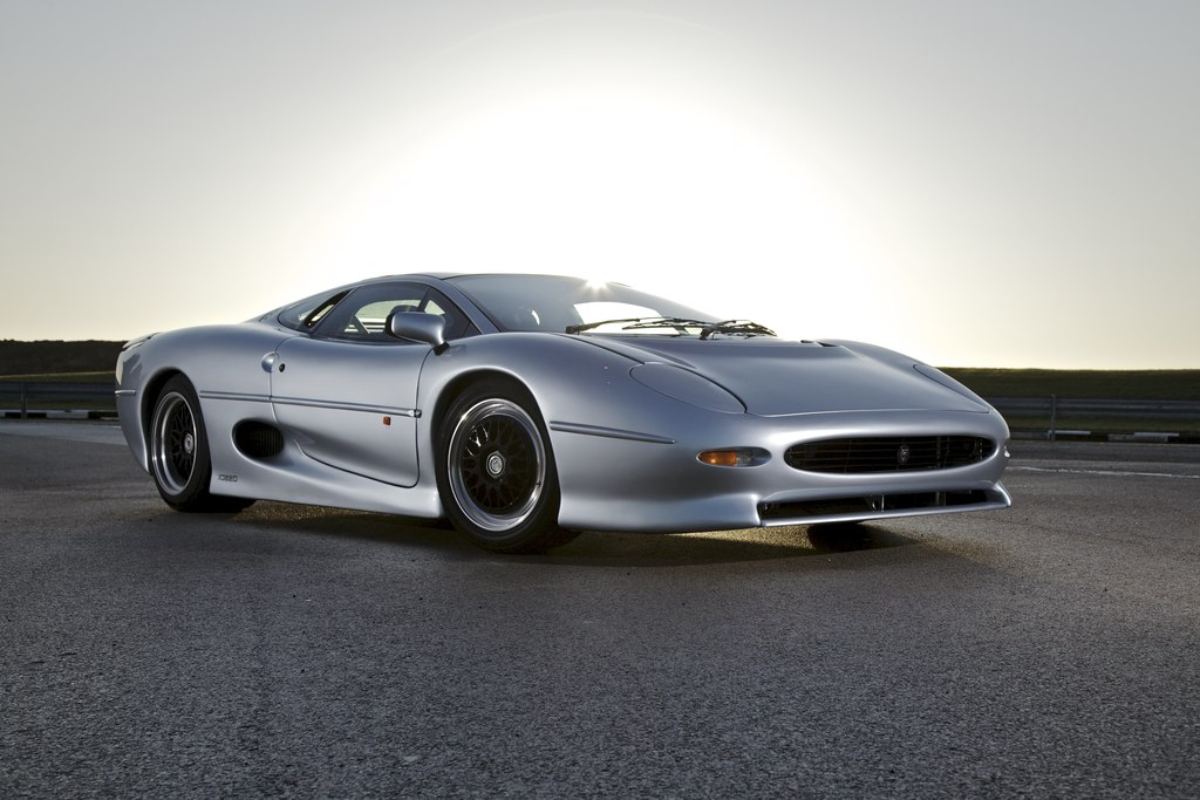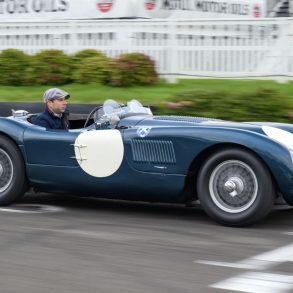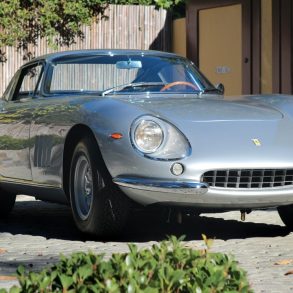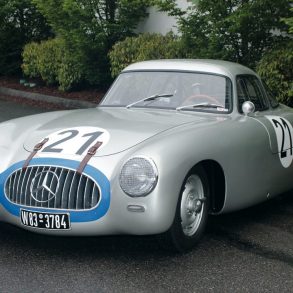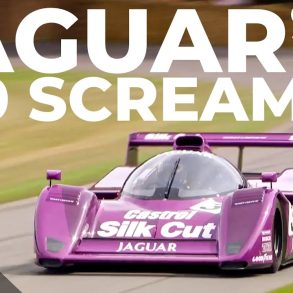For the most part of the 20th century, Jaguar had been a dominant force on the race tracks around the world, winning the 1951 and 1953 Le Mans with the C-Type and 1955-1957 renditions of the race with the D-Type. But ever since the jinxed XJ13, the company was reluctant to put all its efforts into creating a spectacular road car. And then, the early 1990s saw the Jaguar XJ220, a futuristic teardrop-shaped two-seater and a not so subtle reminder that Jaguar has still got it.
This epiphanic moment gave birth to the most spectacular Jaguar in a long time and one of the company’s most iconic creations. On the other hand, the story of the XJ220’s genesis is also tumultuous and full of unexpected turns.
Background
Starting from the early 1980s, Jaguar’s racing program was delegated to Tom Walkinshaw Racing with considerable success. The legendary series of Silk Cut-liveried XJR endurance cars competed in the World Sportscar Championship and IMSA GTP winning the WSC Group C in 1987, 1988 and 1991.

The XJR-9 scored overall triumphs at the 1988 24 Hours of the Le Mans and 24 Hours of the Daytona, followed by Jaguar XJR-12’s double victory for the 1990 rendition of the famed 24-hour endurance races.

On the other hand, road going Jaguars of the era were a completely different breed. Prior to the birth of the XJ220 project, cars you’d see on the streets couldn’t be further from the brisk machinery found on the racing circuits. Ever since the XJ-S came to replace the retired E-Type, Jaguar has been focused on tame luxurious cruisers, be it in coupé, convertible or sedan form. In fact, the line-up consisted of the XJ sedan and XJ-S two-door cars with either six or twelve cylinder engines and it didn’t bring even a fraction of excitement Jaguar was known to deliver in the 1950s and the 1960s.

This dull line-up or lack thereof was sometimes stirred up by third party constructors such as Lynx, Lister and Koenig, but no spoiler packs or shooting brake conversions could hide the fact that Jaguar has lost its sporty spirit and sailed straight into plush cruisers. With its designs being decades old, the XJ and XJ-S were silver haired, and so were Jaguar’s demographics.
Feeling that the discrepancy between the in-house developed road cars and TWR-ran racing program is too big, Jaguar’s Chief Engineer professor Jim Randle started working on a road-going supercar designated for FIA Group B use.

Development
The hectic development process began in late 1987 when Randle started off humbly, with a cardboard model of a futuristic, yet highly evocative supercar. As the next step, he gathered the Saturday Club, a team of twelve volunteers willing to dedicate their spare time towards building the ultimate Jaguar. Moreover, Randle employed his reputation to reach an agreement with part suppliers to donate necessary parts in exchange for staying on the project once it gets green-lighted.
Having established both the team and the resources, Randle embarked on a quest to create one of the most complex supercars of its era. Ten months later, the concept was there and it was a mesmerizing sight fully loaded with the latest technology. Against all odds, the team has done it on zero budget and a hundred percent dedication.
XJ220 Concept: Intentionally complex
The concept car was presented at the 1988 British International Motor Show in Birmingham, completely eclipsing the F40. After all, this was Jaguar’s homecoming in the truest sense of the word. But aside from being a British car presented at a British car show, what made the Jaguar XJ220 concept so impressive it pushed the grand F40 out of the spotlights?

The XJ220 evoked the spirits of the past, being christened as a nod to the XK120. The name of this iconic post-WW2 sports car came from Jaguar’s old nomenclature, stating that it was capable of going 120 MPH in 1948. Exactly forty years later, Jaguar’s goal was to again present the fastest production car in the world by hitting the 220 MPH mark and the XJ220 seemed like the right weapon for the job.
Another goal of the XJ220 was to enter the FIA Group B regulations, or at least the non-rallying part of it. The set of regulations finding its most glorious application in rallying also applied to sports car racing and there’s where Jaguar saw the opportunity to make a breakthrough with an in-house car.

While its name was nostalgic to a certain extent, everything else about the XJ220 was futuristic, even otherworldly. The flowing longtail silhouette was something only seen on the most radical contemporary concept cars like the Oldsmobile Aerotech or the Corvette Indy, but bear in mind that Randle and his team built it not just for show, but to put license plants on it and to win races too. To top it all off, the XJ220 concept had active aerodynamics, namely a rear wing deploying at higher speeds.
What made the XJ220 even more unreal was the fact that the design and development team carried out the project in 1:4 scale, relying only on the original cardboard model of the car. Remember, the team operated on off hours and Jaguar’s team couldn’t afford a full-scale model, so even the aerodynamic tests were conducted on a scale model.

Next was the engine, the 6.2-liter V12 originally engineered by Walter Hassan, but tweaked to 700 horses by Cosworth and raced in the mid-1980s. The potent Double Six had the power to propel the XJ220 to its designated speed and it seemed like the perfect powerhouse for Jaguar’s new road and race car. The concept promised four-channel anti-lock braking, advanced all-wheel-drive developed in conjunction with FF Development, adaptive suspension, and four-wheel steering, two pieces of space-grade technology.
The prospective clientele flocked to reserve a ticket for the 220 MPH Club, at a costly sum of £50,000 for a £470,000 supercar. Judging from the initial presentation, it seemed that Jaguar has got it all, but that’s where the story steers away, turning into one of the biggest and most disappointing twists in the supercar world.
Jaguar XJ22o Concept Car. Source: LoonyGarage
By the time the first XJ220 got off the production line, the car lost six cylinders and most of its advanced features, but it still became the fastest production car in the world. That leaves us with one big ‘what if?’ but also one ‘so what?’.
Anyway, what went south for the XJ220?
JaguarSport Ltd.
Despite the initial spark, Jaguar couldn’t commit to developing the production car in-house, so the company formed a joint venture with TWR, naming it JaguarSport Ltd.

The joint venture proceeded with financial planning and reengineering of the XJ220 concept car and as a result of thorough revisions, the production car was radically altered.
The XJ220 was assembled in a factory at Wykham Mill, built specifically for the car’s production. Princess Diana of Wales opened the factory and uncovered the first car that was soon presented at the Tokyo Motor Show.

Construction of the XJ220
The innards of the XJ220 sat inside of a Alcan bonded honeycomb aluminum structure consisting of two box section rails, an integrated steel roll cage and a monocoque passenger unit.
The construction of the concept car was thus faithfully carried over to the production model, which sadly couldn’t be said for many other components and promised key features of the XJ220.

Body
The production variant of the XJ220 kept the dramatic look of the concept car with very few changes made to the body shape. Upon designing the XJ220, Keith Helfet had two goals on his mind. He strongly wanted to present a modern car, but to still pay honors to the Jaguar’s of the past, most notably the XJ13, a car that sadly never reaped its racing glory.

The outcome was an imposing two-seater with a low-slung silhouette resembling a leaping wild feline.
A car worthy of its name, the streamlined XJ220 was a huge departure from the brand’s subdued identity. Even though its organic curves looked almost space-like, the XJ220 was built traditionally, by the ways of the old masters, with its 4000 series aluminum alloy body panels beaten by hand, a daunting task considering the sheer size of the car.

At first glance, the production variant of the XJ220 indeed looked like a concept car, but in reality, it was shorter and also a bit simplified. In the production process, Jaguar decided to drop the weighty and complicated active aerodynamic spoiler and equip the longtail end with a lighter fixed-wing. As a bit of trivia, the rear lights hiding behind the louvers were sourced from a rather pedestrian Rover 200 sedan.


Engine and Transmission
Losing the active aerodynamics and a few inches of its length was nothing compared to the changes under the swooping body. As previously mentioned, the concept car had a tamed racing V12 engine, rear-wheel steering, and all-wheel drive, but none of these three features found their way on the production car.
One of the reasons the bodywork was shrunk was because the newly appointed engine allowed for less space in the bay, thus the elongated rear end only added unnecessary weight.

The engine itself was dubbed Jaguar/TWR JV6 and it was a 3.5-liter twin-turbocharged V6 mated to five-speed transmission developed by FF Development. The V12 gave way due to uncorrectable emission and reliability issues that raw power just couldn’t compensate for. So, JaguarSport Ltd. redeveloped a unit from the MG Metro 6R4 Group B car to deliver 542 horsepower and 475 lb-ft of torque, an adequate power figure of a new, lighter XJ220. Power-wise, this twin-turbo V6 seemed like an adequate replacement, but it didn’t echo the glory of a proper V12, thus failing the customers’ expectations.

The next bit of underwhelming delivery was dropping the four-wheel-drive in favor of a classic rear-wheel drive. The RWD setup effectively shed more weight but stripped the XJ220 of some of its driving capabilities. But, more importantly, it disappointed the press and the clientele one more time.
Suspension and Steering
In another major letdown, the development team decided to simplify the production XJ220 even more by abandoning rear-wheel steering in the name of saving weight. In addition to that, adaptive suspension gave way to a conventional setup consisting of all-wheel independent suspension with double wishbones, inboard coils with gas dampers, and inboard roll bars.

The XJ220 was fitted with a power-assisted rack and pinion steering, giving the owners a precise and comfortable feel in everyday traffic, where the XJ220 excelled as a surprisingly usable daily-driven supercar.
Brakes, Wheels and Tires
Ensuring stopping power were ventilated cross-drilled discs measuring 330mm in the front and 300mm in the back hugged by four-piston aluminum calipers. In a controversial decision, Jaguar decided to install the brakes without a servo or ABS, catering to seasoned drivers. However, a significant number of owners didn’t find this solution comfortable and demanded retrofitting more user-friendly brakes.

Staggered Speedline Corse alloys measured 17 inches in the front and 18 in the back and were fitted with 255/55 ZR17 front and 255/55 ZR17 rear Bridgestone Expedia S.01 specially developed for the XJ220.
Valuation of the Jaguar XJ220
| Concours | $520,000 |
| Excellent | $445,000 |
| Good | $360,000 |
| Fair | $305,000 |
XJ220 as the fastest car in the world
Above all, the XJ220 was a straight-line performer rather than an all-round capable roadworthy race car. Being 194 inches long, 79 inches wide, and prone to massive oversteer and understeer it was more suited to conquer the production car land speed rather than perform on the tracks or crawl through city traffic.
The speed testing saw Martin Brundle pilot the XJ220 to 212.3 MPH and again to 217.1 MPH with unrestricted catalyzers at the Nardo test track in 1992. While it was a few miles short of the targeted 220, it was enough to crown the XJ220 as the fastest production car in the world.

The XJ220’s reign didn’t last long though. In 1994, the McLaren F1 broke the record by achieving 242.95 MPH, leaving the XJ220 almost forgotten in the ever so interesting speed wars.
Legacy
The recession of the early 1990s and underwhelming alterations during the XJ220’s transition from concept to production stage came as a shock to both the company and the clients. In the end, a total of 281 cars were built and 272 sold, way less and way more slowly than planned. In attempts to pull away from the deal, some disappointed clients even pursued Jaguar legally, hoping to void their contracts on the basis of radically altered features.
The press on the other hand loved the XJ220, putting it on the pedestal of British motoring. The Jaguar supercar was hailed for its undoubtedly amazing performance followed by satisfying ergonomics even for supercar standards, but the press of course deemed it completely horrendous in daily traffic due to its size, unassisted brakes and unoptimized gearbox.

Despite the concept being three steps ahead of the production version and all controversies that followed, the XJ220 was a brilliant piece of automotive design and engineering. The aftermath of Jaguar’s lucid moment wasn’t nearly as glorious as the company wanted it to be, but it was all fun until it lasted. Shortly after the XJ220 ceased production, Jaguar returned to its old ways and under Ford’s guidance, its line-up was rather tediously expanded to two more retro-modern sedans.
Jaguar’s renaissance under Tata Motors almost birthed a successor to the XJ220. It was the C-X75, a remarkable 2010 supercar concept which sadly never transcended beyond the show car stage despite the company’s plans to put it in production. The global recession forced Jaguar Land Rover to pull the plug on it, leaving the XJ220 heirless for now.

Three decades later, Jaguar hasn’t made a faster road car, nor any production car to even come near succeeding the XJ220. Despite its inherent flaws and unfulfilled promises, this fact, in particular, makes the XJ220 the greatest and by far the most memorable Jaguar of the modern era.


